A small but relatively prominent southern hemisphere constellation, not visible from our location, lies in the Milky Way south of the Scorpius constellation, between the star θ Scorpii on one side and α Triangulum Australis on the other. It is also indicated by the two brightest stars of Centaurus, Hadar, and Rigil Centaurus. The Altar constellation has a distinct shape, resembling a chair or throne with its outlines in the sky. It can be easily located in the Milky Way south of Scorpius, but visibility requires an observation point with at least a 65th parallel southern declination. The constellation is composed of several stars, including the brightest star β Arae with an apparent magnitude of 2.85, an orange giant located 600 light-years away. Other notable stars in Altar include α Arae with a magnitude of 2.95, γ Arae with a magnitude of 3.34, ζ Arae with a magnitude of 3.13, δ Arae with a magnitude of 3.62, θ Arae with a magnitude of 3.66, and η Arae with a magnitude of 3.76. Three of them—β, ζ, η—are orange in color. Altar contains several interesting deep-sky objects, with dominant globular clusters such as NGC 6352, NGC 6362, and NGC 6397, as well as the open star cluster NGC 6208, which has a magnitude of 7.
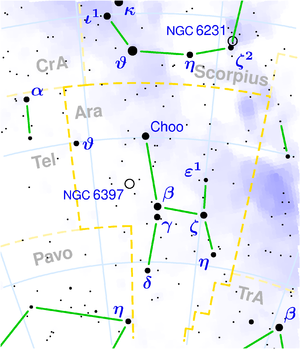
R Ara - An eclipsing variable star of Algol type, with a period of 4.4 days and a magnitude change from 6.0 to 6.9. In the field of view of the telescope, it is located along with the stars ζ and η Ara.
U Ara - A variable star of the Mira type, whose brightness is sufficient even for smaller telescopes - at maximum it reaches 8mag. However, in minimum its brightness decreases by a whole five magnitudes. It exhibits changes in a period of seven months.
NGC 6397
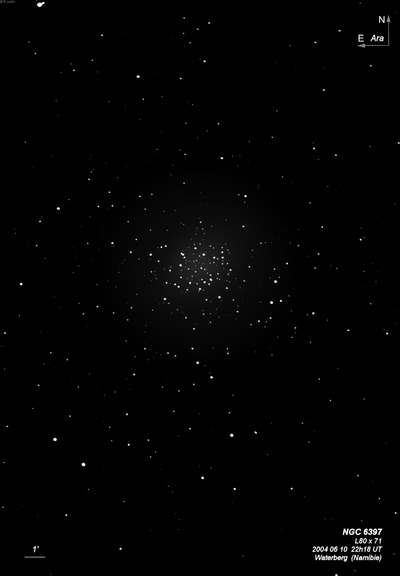
10x30 (8/8/04 - Haleakala Crater): picked up while sweeping in IS binoculars close to the SSW horizon from Haleakala. Once the position was pinpointed, this mag 5.8 globular was just visible naked-eye less than 1 degree NNE of mag 5.3 Pi Arae.
Nicolas-Louis de Lacaille discovered NGC 6397 = Lac III-11 = D 366 = h3692 in 1751-1752 with a 1/2" telescope at 8x, during his expedition to the Cape of Good Hope. He simply noted "faint star in nebulosity." James Dunlop independently found this globular on 28 Jun 1826 with his 9-inch reflector and described "a pretty large nebula, extended nearly in the parallel of the equator, brightest and broadest in the middle; a group of very small stars in the middle give it the appearance of a nucleus, but they are not connected with the nebula, but are similar to other small stars in this place which are arranged in groups. The nebula is resolvable into stars." Dunlop made 4 observations and his position was 5' east of center.
On John Herschel's first observation (8 Jul 1834), he recorded "globular cluster; fine; large; bright; round; gradually brighter to the middle; not very compressed; 5' diameter, but stragglers extend a great way. In the middle is a more compact group of much smaller stars. The stars at circumference are larger than in the middle; at N.f. border is a double star."
200/250mm - 8" (7/13/91 - Southern Baja): very bright, very large, 10' diameter, irregularly round. At least 50 stars mag 10-12 are resolved at 63x. Bright intense core 3' diameter with dozens of stars superimposed and at the edges of the core. The cluster contains a large halo with many faint and brighter stars superimposed over a mottled background. Beautiful globular although observed at only 13° elevation from Baja. This is the nearest globular and first in ranking by brightest stars.
400/500mm - 20" (7/8/02 - Magellan Observatory, Australia): I also had a fantastic view in the 20" f/5 at 212x - the stars seemed to radiate out from the core in spiral curves and completely filled the 23' field!
Notes by Steve Gottlieb
NGC 6193

James Dunlop discovered NGC 6193 = D 413 = h3640 with his 9-inch f/12 reflector from Parramatta, New South Wales. He reported "A cluster of small stars, with a bright star in the preceding side. A very considerable branch or tail proceeds from the north side, which joins a very large cluster." He did not mention any nebulosity.
On 15 Apr 1836, John Herschel described a "cluster VIII; consists of about a dozen stars 10..11m, and perhaps as many less, with stragglers, which fill field. In its preceding part is a fine double star [HJ 4876] and yet more preceding is a vL, faint nebula [NGC 6188], in which the preceding part of the cl is involved."
200/250mm - 8" (7/13/91 - Southern Baja): 45 stars in a 15' diameter at 63x. Includes a bright mag 5.6/6.8 double star at 10" separation and mag 7 SAO 227038 6' W. A circular group of seven fairly bright stars is just east of the double star with a fainter curved string of stars in the center. There are several brighter stragglers on the east side. The cluster is generally spread out with no rich regions. Extensive nebulosity is involved (see NGC 6188).
8" (7/17/82): three bright stars including h4876 (6.0/7.0 at 10"). Many faint stars are visible with averted vision. Includes emission/reflection nebula NGC 6188. This star-forming region is extremely far south for viewing from the Sierra foothills (only 2.5° above the horizon)!
400/500mm - 18" (7/10/02 - Magellan Observatory, Australia): at 117x, ~75 stars were visible in a 15' field surrounding the ionizing source HJ 4876, a bright 10" double consisting of mag 5.6 O3-type HD 150136 and mag 6.8 O6-type HD 150135. I also saw a couple of very faint mag 15 companions to the bright double. In addition, a 7th mag star (HD 150041) is on the west side of the cluster. These three bright stars are encased in nebulous halos that respond to a UHC filter (indicating emission). The cluster itself is scattered with no central concentration and includes a mixture of mostly bright and some very faint stars. A perfect ellipse of moderately bright stars is just southwest of the main portion of the cluster. Interestingly, the center of this ring is mostly free of the nebulosity (RCW 108) that permeates the field (see NGC 6188 for description) . The RCW 108 complex is in the Ara OB1 association, one of the youngest and closest star-forming regions.
Notes by Steve Gottlieb
NGC 6352
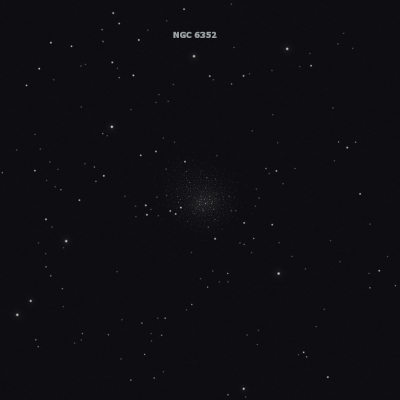
James Dunlop discovered NGC 6352 = D 411 on 14 May 1826 and recorded "A rather faint nebula, of an irregular round figure, 4' diameter, slightly branched; easily resolvable into stars, with slight compression of the stars to the centre." His position is ~15' too far east (typical error). John Herschel didn't observe this globular from the Cape, so it doesn't have a General Catalog designation.
E.E. Barnard independently found it on 7 Jul 1885 (Sidereal Messenger 4, page 223) and assumed it was new since it was missing from the General Catalog, but Lewis Swift informed him of Dunlop's prior discovery.
200/250mm - 8" (7/13/91 - Southern Baja): moderately bright, fairly large, 5' diameter, fairly low surface brightness, not condensed, brighter core but no sharp nucleus. Partially resolved into 5-10 faint stars mostly on the SW side.
300/350mm - 13.1" (7/12/86): faint, small, diffuse, low surface brightness spot. A few faint stars are off the SW edge but there is no resolution. This is the farthest southern globular I've observed from Northern California (Digger Pines) with an elevation of only a couple of degrees.
400/500mm - 18" (7/10/02 - Magellan Observatory, Australia): fairly bright, fairly large. Even at 128x, the cluster was fairly well-resolved into roughly 75 stars. It displayed a rather loose concentration class with a broad central concentration to a moderately bright 3' core. The irregular halo extended to nearly 8' diameter. Set in a rich Milky Way field.
Notes by Steve Gottlieb
NGC 6362
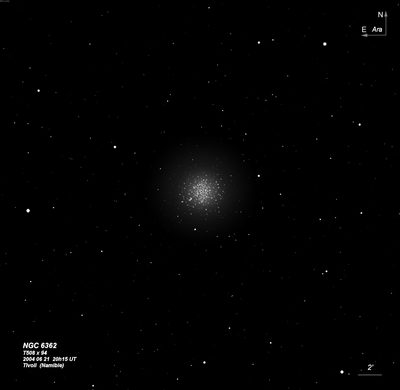
James Dunlop discovered NGC 6362 = D 225 = h3684 on 25 Jun 1826 and described a " pretty large rather bright round nebula, 3' or 4' in diameter, very moderately condensed to the centre, resolvable into extremely minute stars; the stars are more scattered on the south side."
On 22 Jul 1835, JH recorded "globular cluster, B; L R; vgmbM; diam. in RA = 50 second; diam 7' or 8'; stars all seen, 12..16th mag with outliers extending a good way."
300/350mm - 12" (6/29/02 - Bargo, Australia): at 186x, this fairly loose globular appeared moderately bright and large and broadly concentrated. It was resolved into 25-30 stars with several of these arranged in a line bisecting the cluster. The ragged halo was roughly 8' in diameter. Located 1.2 degrees NE of mag 4.7 Zeta Apodis.
400/500mm - 18" (7/11/05 - Magellan Observatory, Australia): fairly impressive globular cluster; bright, large, scraggly, with roughly 60 stars resolved over a 7'-8' diameter. A distinctive string of resolved stars passes through the entire cluster in a NNW to SSE orientation. A mag 10 star is near the edge of the halo on the south side, 3.5' from center.
Notes by Steve Gottlieb
NGC 6326
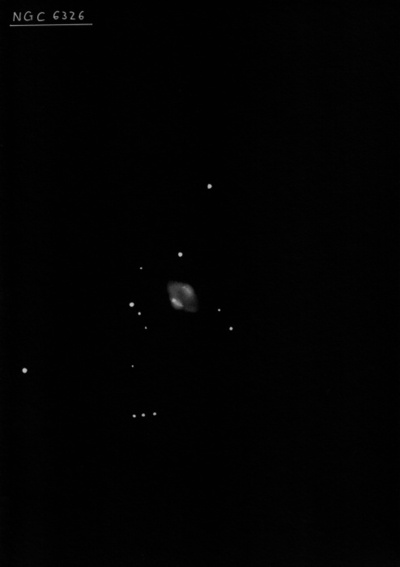
James Dunlop possibly discovered NGC 6326 = D 381 = h3675 on 26 Aug 1826 and described "an extremely faint small nebula, about 12" diameter, with a bright point in the centre." The size certainly fits, though his position was off by 24' (too far east) and this identification is uncertain.
Joihn Herschel gave two very detailed observations. On 19 Jun 1835 he logged "planetary nebula, delicate, F, vS, diam = 6 or 7 arcseconds, exactly round, perfectly uniform (as respects the graduation of the light from the centre to the edges), but the light a very little curdled. Not the slightest haziness, but like a star out of focus. 320x shows rather more fur at the edges than I think it would to a planet of equal size and light. Its light is = a star 10-11th mag. It would be quite useless to look for this object under less favourable circumstances -- of instrument and sky. A night of gloriously perfect definition! It is in a very rich place. There are 40 or 50 small stars in field. Measures of the two companions; 1st pos = 351 degrees, dist = 1 diam from edge, star = 14th mag; 2nd pos = 91.4, dist = 2/3 diam, star = 13th mag. Showed it to my attendant, J. Stone, who saw it well". His sketch in on Plate VI, figure 6.
In a later sweep (6 Jun 1837) the comment was added "Referring to the description of D 381, I see no ground to suppose that this can by possibility have been the object intended by that place and description. At all events the remarkable planetary character has escaped notice by the author of that description."
Joseph Turner sketched the planetary on 16 Aug 1874 using the 48" Great Melbourne Telescope. His sketch (unpublished plate VII, figure 74) shows the two nearby stars and no additional features though he noted a softness at the edges and a slight "curdling" appearance.
400/500mm - 18" (7/8/02 - Magellan Observatory, Australia): very bright, small, round compact PN in a dense field of stars. A couple of mag 13-14 stars are just off the north and east sides. At 171x and UHC filter, the crisply defined periphery is slightly elongated and evenly illuminated with no hint of a central star. The diameter appears to be ~15" with a V mag of approximately 10.5. Located 3.5° NE of gc NGC 6397 and a similar distance SSW of gc NGC 6352.
Notes by Steve Gottlieb
IC 4642
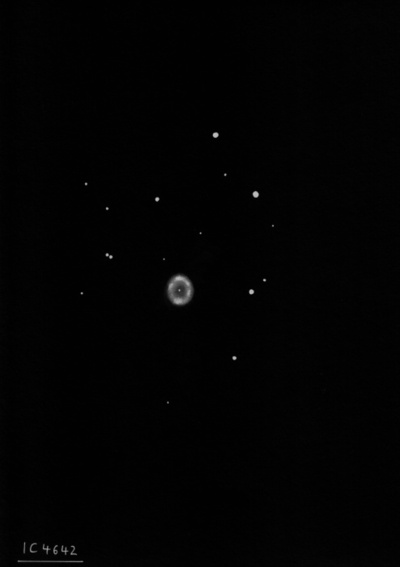
Williamina Fleming discovered IC 4642 = Fleming 96 in 1901 on a Harvard objective prism plate taken at the Arequipa station. Harlow Shapley reported it as a new discovery in a 1936 paper "Five Planetary Nebulae and a Globular Cluster". This paper also includes Shapley 1 and 3.
400/500mm - 18" (7/8/02 - Magellan Observatory, Australia): fairly bright, small, round, compact planetary in a rich star field. Picked up immediately at 171x and UHC filter as the 15" disc was obvious. At 228x the surface seemed a bit irregular with a hint of a starry center. Located just north of the midpoint connecting Beta and Zeta Arae, 2° ESE and 2° WSW.
Notes by Steve Gottlieb
NGC 6188
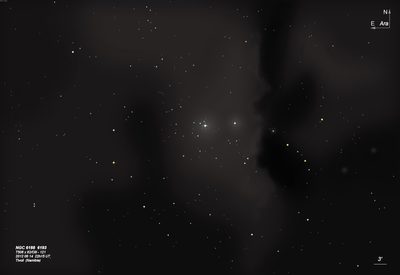
John Herschel discovered NGC 6188 = h3640 on 15 Apr 1836 and recorded "The brightest part of a vL, faint, diffused, branching nebula, which involves in it nf part the star Brisbane 5789, and extends into the cluster D 413 [NGC 6193], which it in part surrounds. No doubt about the nebula, which in the brightest part of it precedes the cluster about 1 min of time. The following stars behind the double star, and quite free of nebula. I presume the neb and cluster to be unconnected." His rough position (nearest minute of RA and nearest minute of dec) was poor; it lands to the southwest of the nebulosity, about 22' SW of[NGC 6193, although he states the "brightest part of precedes the cluster about 1 min of time."
Despite many attempts, Joseph Turner (on 2 Jun 1877 and 16 Oct 1878) and Robert Ellery were unable to find this nebula with the Great Melbourne Telescope. This might be due to Herschel's poor position or the GMT's field of view was too small at the lowest power of 234x with a 14' field.
200/250mm - 8" (7/13/91 - Southern Baja): very large faint nebulosity which envelops open cluster NGC 6193, about 20' diameter. Extends roughly E-W through the cluster but also a very long brighter streak oriented N-S extends mainly to the south on the west side of cluster. This streak is well defined with an abrupt edge but there is no contrast gain with a UHC filter.
8" (7/16/82): faint, moderately large, low surface brightness glow on the west side of open cluster NGC 6193. This object is very low on the horizon from Northern California (less than 3 degrees max elevation).
400/500mm - 18" (7/10/02 - Magellan Observatory, Australia): With the 27mm Panoptic at 76x and UHC filter, this is an amazing region of bright and dark nebulosity involving open cluster NGC 6193 and extending throughout the entire 51' field in a N-S orientation. The bright nebulosity is split into two large sections by a dark lane that runs N-S. The eastern portion is the most prominent and includes the scattered cluster NGC 6193 and its three brighter stars (5.6/6.8/7). On the southern end of this section the nebulosity tapers down towards the SW corner, 15' to 20' from the core of the cluster. The western rim of the nebula is sharply defined with a locally brighter, crisp edge delineated by the dark river that meanders N-S throughout the field. The eastern and northern ends fade into the rich Milky Way background field.
A nearly perfect ellipse of moderately bright stars is just SW of the main body of the cluster and beyond the edge of nebulosity into the rift. The center of this ring is within the highest contrast portion of the dark rift, although the eastern side of the ring intersects the bright edge. This 15'x10' loop of stars spans the two sections of nebulosity.
The western portion of the nebulosity extends mostly NW of the elliptical ring and is clearly fainter. The highest contrast is along its eastern rim and runs N-S, roughly parallel to its brighter counterpart on the east side of the rift. The nebulosity fades towards the north and west with no well-defined edge but again is quite extensive. The catalogued dimensions of 20'x12' are too small and covers only the brightest portion of this much more extension HII/dark nebula complex.
Notes by Steve Gottlieb
NGC 6250
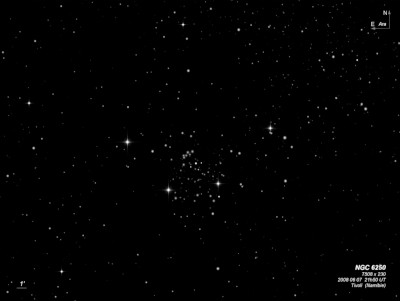
John Herschel discovered NGC 6250 = h3656 on 1 Jul 1834 and recorded a "cluster VIII class; loose and straggling; place that of a D * [HJ 4899 = 9.8/10.0 at 2"] in central more condensed group; has a * 8m sf, 5' dist, and another 7m more remote. His position is on the close double star.
200/250mm - 11" (8/8/04 - Haleakala Crater): at 127x a dozen stars are packed into a tight 2' group. Consists of a knot of 6 stars on the NE side and a looping curve of 5 or 6 stars on the SW side. This "core" is surrounded by a scattered 10' group of perhaps three dozen stars including three mag 7.5-8.5 stars to the SW and SE by 3' and to the east by 6'.
300/350mm - 13.1" (4/10/86): tight, rich group of 6-10 stars over an unresolved haze. Set among a larger scattered group of bright stars.
400/500mm - 22" (6/28/06 - Hawaii): small group of a dozen stars in a tight 2' cluster including mag 9.2 HD 152822. Surrounding this knot is a larger, 14' scattered group of stars, elongated ~E-W, that appears to be a separate superimposed cluster. Three mag 7.5-8.5 stars are in this larger group to the SW, SE and E of the central clump and a mag 9 star is among a small subgroup at the east edge.
Notes by Steve Gottlieb
IC 4651
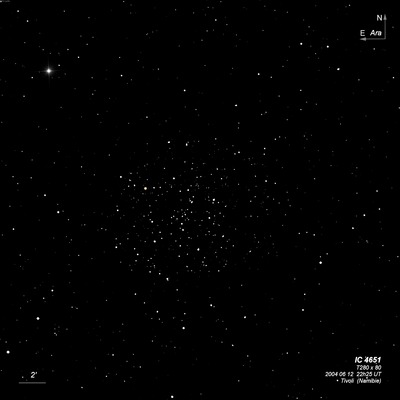
James Dunlop discovered IC 4651= D 402 on 28 Jul 1826 and described "a very fine round cluster of very small stars, slightly compressed to the centre, about 8' diameter." His position is on the south side of the cluster, so the identification is certain.
Solon Bailey rediscovered the cluster on a photographic plate in 1896 using a 1" lens at the Arequipa station. The discovery was reported in "A Catalogue of Bright Clusters and Nebulae" (Annals of Harvard College Observatory, Vol LX, No. VIII, 1908). Bailey was credited with the discovery in the IC as John Herschel didn't confirm Dunlop's observation.
200/250mm - 11" (8/8/04 - Haleakala Crater): IC 4651 was first noticed in my 10x30 IS binoculars while looking at NGC 6352. It was seen as an obvious knot 1.5° to the south. At 127x, I was surprised to find a beautifully rich open cluster with over 100 stars mag 10-13.5 in at least a 15' field. The stars are fairly uniform in distribution with a weak central concentration, though several form loops and chains surrounding blank regions. The brightest star (mag 8.9 K3-type) is on the east side. This is an intermediate-age cluster between 1-2 billion years old. Located 1° west of mag 2.8 Alpha Arae.
Notes by Steve Gottlieb
NGC 6208
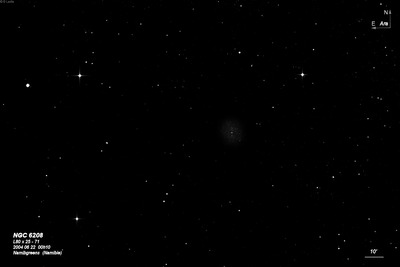
James Dunlop discovered NGC 6208 = D 364 = h3646 on 28 Jul 1826 and recorded "A round, faint nebula, about 1' diameter, with three small stars in it; a bright star south of the nebula." His position is 8' south-southwest of the center of the cluster. On 8 Jul 1834 from the CGH, JH logged "A pretty insulated milky way cluster, class VII of large stars; 8' diameter; stars 9...12th magnitude." On a second sweep he called it a "cluster class VII; rich; not much compressed in the middle; more than fills field; stars 11...14th mag but chiefly small."
400/500mm - 18" (7/9/02 - Magellan Observatory, Australia): best at 76x with 27mm Panoptic. Appeared as a 10' cloud of mostly fainter stars which blends into the surrounding field with many stars arranged in an elongated, curving shape. Includes a mag 10 star on the south side, though the majority are 12-13th magnitude.
Notes by Steve Gottlieb
NGC 6200
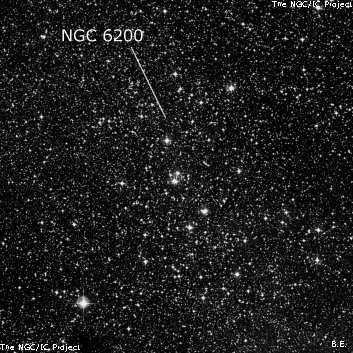
John Herschel discovered NGC 6200 = h3643 on 1 Jul 1834 and recorded "a great space full of milky way stars, so thickly sown as to merit being called a cluster." His position and description matches this large cluster.
200/250mm - 8" (7/13/91 - Southern Baja): about 75 stars in a 20' diameter at 63x. Bright, large, rich, many stars mag 9-11 over a carpet of faint stars. Mag 7.1 SAO 227144 is off the SE edge 13' from the center of the cluster.
400/500mm - 22" (6/28/06 - Hawaii): at 110x this large, rich open cluster resolves into roughly 200 stars, extending over one-half the 22mm Panoptic field (~20'x15'). A very close triple star is near the center (one component fainter) and a wider pair lies 3.5' NE.
Notes by Steve Gottlieb
NGC 6204
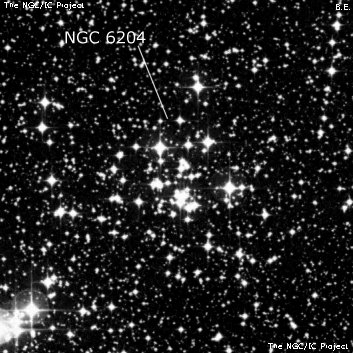
James Dunlop discovered NGC 6204 = D 442 = h3644 on 13 May 1826 and recorded "seven or eight small stars in a group, about 1' diameter, with a minute line of stars on the north side." His position is 15' too far northeast, typical of his rough positions.
John Herschel first recorded NGC 6204 on 1 Jul 1834 as a "cluster moderately compressed class VIII; stars 11.12th mag; S.f. is a brilliant knot of stars, one of which is 8th mag, and the others 9th magnitude." On a later sweep he noted a "singular shaped cluster, irregularly round, compressed VII class, set as it were in a nearly rectangular frame of stars detached from cluster." He included a sketch of the unusual star chains in Plate V, figure 6 and the "brilliant knot of stars" south following is Hogg 22.
200/250mm - 8" (7/13/91 - Southern Baja): about 40 stars in 8' diameter at 63x. Rich appearance over an unresolved haze. A close triple star is in the center with four bright mag 8-9 stars in a tight group off the SE edge (this is a separate cluster Hogg 22).
8" (7/16/82): only a few faint stars are visible over unresolved haze but appears to be rich. This is one of the southernmost clusters I've viewed from Northern California latitude.
400/500mm - 18" (7/9/02 - Magellan Observatory, Australia): at 171x, this is a bright cluster with roughly 80 stars in a 7' circle. Near the center is knot of four stars with additional very faint stars huddled around at 228x. Many of the stars in the cluster are arranged in a few loops and chains. Most of the brighter stars in the cluster are situated around the edges including a line of four stars at the east edge. Four bright stars are off the SE side including mag 7.3 SAO 227189 (catalogued as Hogg 22).
Notes by Steve Gottlieb
NGC 6221
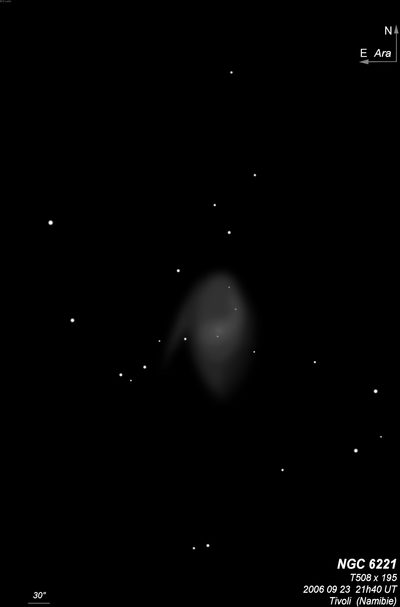
John Herschel discovered NGC 6221 = h3649 on 3 May 1835 and recorded "pF; L; R; glbM; 80"." On a second sweep (5 Jul 1836), he logged it as a "Globular cluster; pB; pL; R; gbM; 2 1/2' dia; barely resolvable."
400/500mm - 18" (7/8/02 - Magellan Observatory, Australia): fairly bright, fairly large, slightly elongated N-S, ~2.5'x2.0', broad concentration to a small brighter core. I was surprised there was a strong impression of a spiral arm along the west side of the halo extending to the north. A very small knot was seen at the northern end, probably within this spiral arm. Brightest in a group with NGC 6215 19' NW. Located 25' SE of mag 3.8 Eta Arae in a rich Milky Way field.
Notes by Steve Gottlieb
NGC 6300
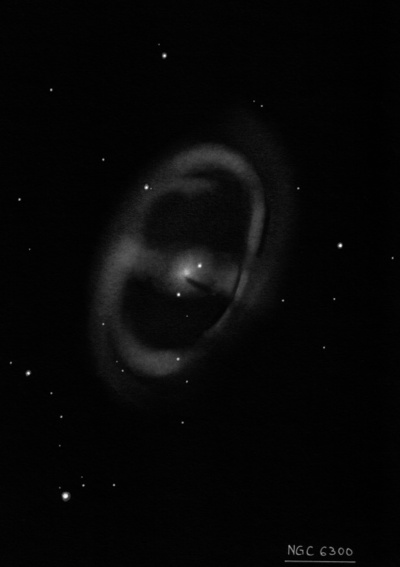
James Dunlop discovered NGC 6300 = h3668 on 30 Jun 1826, according to Glen Cozens who examined his handwritten notes (on microfiche). For some reason, though, Dunlop didn't include this object in his catalogue.
John Herschel rediscovered NGC 6300 = h3668 on 30 Jun 1826 and recorded "F; vL; R; vgvlbM; 3'; has several stars, one = 11m; involved but being on a rich ground, there appears no connection." Herschel was credited with the discovery in the NGC.
400/500mm - 18" (7/11/05 - Magellan Observatory, Australia): NGC 6300 is a very unusual galaxy at a low galactic latitude with an appearance similar to a fairly large emission nebula in a rich Milky Way star field! The shape seemed irregular, but elongated 5:3 NW-SE, ~3.0'x1.8' with a weak concentration to a slightly brighter core. Two brighter stars (mag 12.5) are superimposed on the core and another two mag 13.5 stars are superimposed near the north and south ends of the halo! These stars confuse the observation of this strange looking galaxy (a dusty barred spiral with ring). Located 9.5' SW of mag 7.6 HD 155797.
Notes by Steve Gottlieb
IC 1266
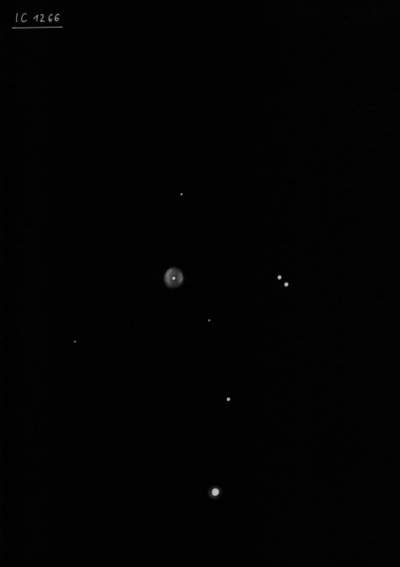
Williamina Fleming discovered IC 1266 in 1894 on a photograph of stellar spectra taken at the Peruvian Station of the Harvard College Observatory. Pickering announced the discovery in AN 3227. Dana Patchick discovered that Tc 1 is identical to IC 1266.
300/350mm - 13.1" not found. Very low emission.
Notes by Steve Gottlieb
Sp 3
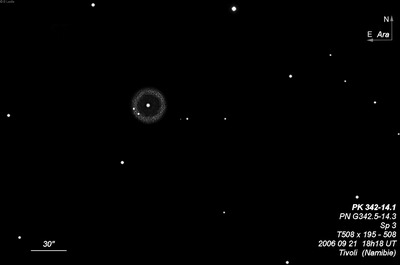
| Type | PN |
| RA | 18:07:15.8 |
| Dec | -51:01:10.0 |
| major_axis | 36.0'' |
| mag | 11.9 |
| surface_bright | 10.5 |